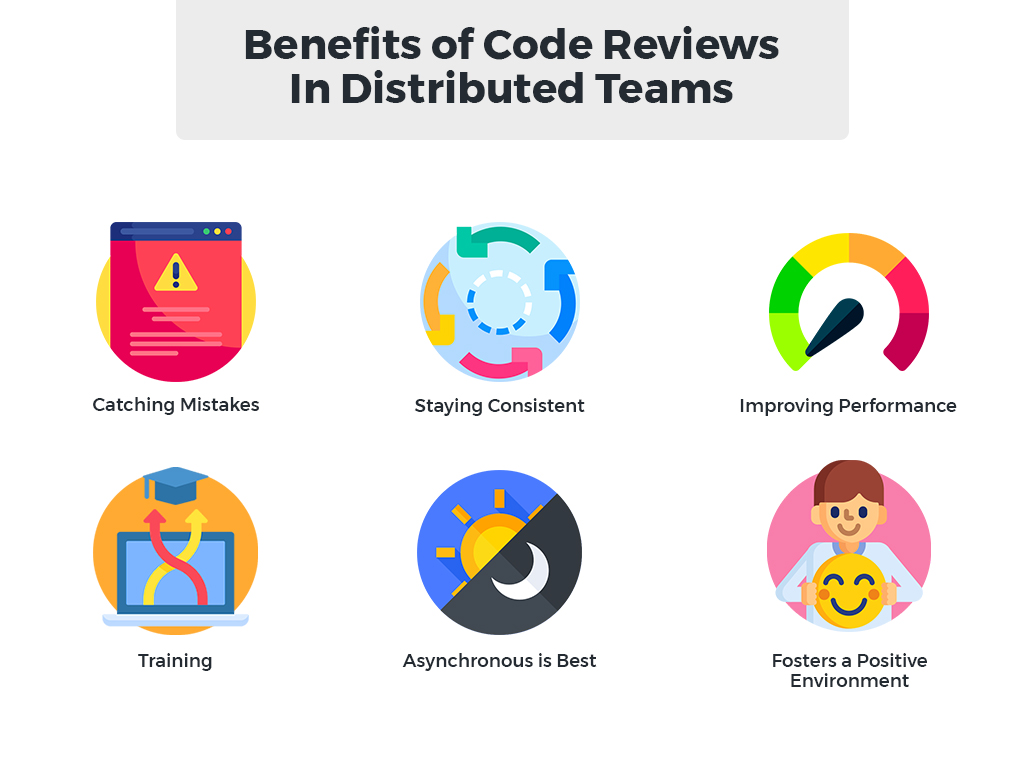There are a lot of compelling reasons to carry out code reviews. A regular review process helps you find bugs early, making rectification easier. It also ensures higher coding standards and consistency among your development software team.
In addition, providing a solid code review can be an interview in itself if you’re assessing a developer’s skill. This is one of those tests that requires both tech knowledge and management abilities.
In this article, we’ll explain what code review is, explore its advantages, and guide you through essential steps to make the process more effective with the right tools.
What Is Code Review?
A code review is a systematic examination of software source code. The aim of this process is to identify bugs and give a precise estimation of the code quality. The process of code review is used for:
- Improving practices: Structuring more efficient ways to complete daily tasks.
- Error detection: Finding logical errors and bottlenecks.
- Vulnerability exposure: Isolating common vulnerabilities.
- Discovering malware: Detect suspicious pieces of code, backdoors, or malware integrated into the software.
It’s especially beneficial for developers who are geographically distributed, where Agile and remote workers often handle tasks autonomously based on their expertise. Code reviews ensure efficient task and skill integration, reducing the chances of overlap or misunderstandings in such teams.
How to Perform a Code Review?
There are eight primary strategies to perform a code peer review:
1. Frame Your Code Review as “Improving Clarity,” Not “Finding Fault”
Before reviewing code, change your mindset. You are not there to prove there is something wrong with the work of the other developer. You are there to show that the code can be clearer and more maintainable.
This approach takes code reviews from “Uh oh, you did something wrong” to “Wow, you are awesome—yup, that can be improved, let’s do it together.” It improves both the code and the relationships.
Then, you need a structured approach. The best way is to follow a logical progression (first big picture, then specifics, then wrap-up), which takes us to step two, which is to explicitly follow a checklist.
2. Have a Technical Review Checklist
When reviewing code, systematically examine multiple technical dimensions to ensure comprehensive coverage. Start by verifying the code’s functionality. Does it work correctly for expected inputs, and do you handle edge cases appropriately?
Next, evaluate the overall design and architecture: Are components well-organized, follow good design principles, and fit logically within the existing system? Focus heavily on readability since code is read far more often than it’s written—can your teammates quickly understand the code’s purpose without extensive mental parsing?
Check that error handling is robust, with proper exception management and graceful handling of unexpected scenarios. Consider performance implications, looking for obvious bottlenecks, inefficient algorithms, or unnecessary resource usage that could impact scalability. Don’t overlook security concerns like input validation, injection vulnerabilities, or exposed sensitive data. Ensure the code maintains consistency with team standards and established conventions.
Finally, assess testability. Is the code structured to facilitate the writing of comprehensive unit tests?
Quick Review Checklist:
- ✅ Easy to test & verify
- ✅ Functionality & edge cases covered
- ✅ Clean design & architecture
- ✅ Code is readable & clear
- ✅ Error handling is robust
- ✅ No obvious performance issues
- ✅ Security considerations addressed
- ✅ Follows team conventions
3. Use Systems to Focus on What Matters
Your time, and your team’s time, is expensive. You can’t afford to have high-level conversations bogged down by trivialities.
Automating the small stuff and defining clear standards can avoid trivial discussions. Set up linters, formatters (like Prettier or Black), and static analysis tools in your CI pipeline so you never have to debate brace placement, indentation, or line length again.
Create a simple team document that defines “good enough” standards: what requires tests, what test coverage percentage you aim for, and what’s a minor suggestion versus a blocking issue. Use prefixes like [nitpick] for non-blocking comments so everyone knows what needs immediate attention versus what’s just a helpful suggestion.
Quick Setup:
- Focus review time on logic, not style
- Automate formatting with linters/formatters in CI
- Define clear “good enough” standards
- Use comment prefixes ([nitpick], [blocker])
4. Don’t Make Assumptions Instead of Questions
A typical pattern in code review is mistaking unclear code for incompetent coding. Where there is confusion, there are questions to ask, and when there are questions, you will need to understand the author’s intention more clearly.
Feel free to ask questions like “I can see here that the function is not thread-safe. Is it only going to be used in a single-threaded scenario?” Not only does that potentially prevent you from making an incorrect remark, but it also shows the interviewer you are aware of context.
Making unchecked assumptions could lead you to “find faults” that aren’t actually issues under the given conditions.
5. Provide respectful feedback during reviews
How you communicate is just as important as what you find. Poorly delivered feedback can create friction and demotivate your teammates.
One of the worst things that can happen in a code review is to leave unclear comments to the receiver (who wrote the code). It defeats the aim of the requested feedback and leaves them confused.
Suppose you want a receiver to make a change. In that case, ensure the receiver understands the change you’re requesting. Perhaps you don’t feel strongly about a comment that you left; you want to make sure they know that.
For example, if you leave a comment in a code review that is merely a suggestion — meaning you don’t care whether they address itthem or not — follow up with a comment and say, “I don’t really feel strongly about this, though. Use your judgment.”
That lets the receiver know they can decide whether or not to act on that comment.
Another type of clarity you can put in a comment is by saying, “Hey, Sanity check: is this what you meant to do here, or is this why you’re doing this here?” Then, you can add a follow-up comment saying, “By the way, this is non-actionable. I’m just asking for clarity.”
The idea is to be overwhelmingly clear to the person you’re doing a code review for. This way, they understand your intentions and don’t feel blocked afterward. This goes a long way when working with a remote team, people in different time zones, or cross-teams, you may not have a rapport with.
As you embrace this practice, it will positively impact your team. During peer reviews, they communicate better, leading to better collaboration and software quality.
6. Asynchronous Review Scheduling
Make the habit of setting time slots for reviews, and accommodating different time zones for continuous feedback.
Use tools like shared calendars or scheduling software to ensure everyone knows when to review and provide feedback, maintaining a continuous, non-disruptive workflow.
7. Code Annotation and Commenting
Encourage team members to add detailed comments and annotations directly in the code or review platform. This should include explanations for suggested changes, questions about specific code segments, and general observations, facilitating clearer understanding and communication.
8. Follow-Up Meetings
After the initial review, schedule short meetings to discuss significant or complex issues that emerged. These meetings should focus on resolving misunderstandings, agreeing on solutions, and planning implementation strategies, ensuring everyone is on the same page.
How Does Code Review Work for Remote Teams?
Any team can benefit from code reviews, regardless of the type of business or field. For remote teams, however, setting up a code review process can bring countless benefits to the workflow. When the team is decentralized, with this process, your developers can work on the same tasks, sharing the same knowledge, rather than waiting for the only person able to get the job done.
You won’t be surprised to hear that the key to making it happen is communication. Solid communication is the foundation of remote teams. We won’t ever stop saying this.
So, when you introduce your code review process, integrate each step in your current workflow and, more importantly, don’t forget to document.
Take into account these steps:
- Establish a clear workflow including the code review in your current workflow;
- Document and give as much as detailed information you can to support the code review process.
- Arrange regular meetings to align on goals and details, using screen share, whiteboard, or team-based tools.
- Adapt and adjust the process considering bottlenecks, necessary updates, and feedback.
- Complete the code review process only upon approval.
To ensure each of these steps works properly, you must ensure a solid communication process. Don’t rely on email. Instead, establish clear guidelines, clearly display different availability schedules, and set up an internal reporting system.
Recommended Tools for Code Reviews in Remote Teams
When managing remote teams, choosing the right code review tools is crucial for effective collaboration. Here are some top recommendations:
- GitHub: Offers an intuitive platform for code review with features like pull requests, issue tracking, and team management.
- GitLab: Provides a comprehensive DevOps platform, facilitating code reviews within a broader suite of tools.
- Bitbucket: Ideal for teams already using Atlassian products, offering seamless integration with Jira and Trello.
- Review Board: A web-based tool that supports pre-commit and post-commit reviews.
- Phabricator: A suite of open-source tools, including differential code review, repository hosting, and more.
Each of these tools has unique features tailored to different team needs and workflows. By integrating these tools into your remote team’s operations, you can streamline the code review process, enhance collaboration, and maintain high-quality code standards.
Benefits of Code Reviews In Distributed Teams
We believe that code reviews are even more important when you are managing a remote dev team. Here’s why:

1. Detect Errors and Bugs
In co-located settings, developers can easily seek help from colleagues. However, in remote software teams across different time zones, addressing issues becomes more challenging.
Code reviews offer a solution that allows knowledge sharing asynchronously. This way, developers can request assistance with their schedules, accommodating different time zones and work-life balances.
2. Consistent Coding Standards
Coding standards ensure consistency, making maintenance easier. In physical offices, shared spaces and cultural norms bolster this consistency.
For remote teams, the challenge is balancing this consistency with the creativity that comes from diverse backgrounds. Code reviews play a crucial role in maintaining standards while fostering creative and unique problem-solving approaches within the team.
3. Enhancing Efficiency with Collaborative Review
In remote teams, code reviews bring an extra layer of scrutiny, often from more experienced eyes, leading to optimized development practices.
Reviewing code remotely ensures maximal efficiency and discourages redundant coding efforts, saving time and streamlining project progression.
Research by SmartBear found that code reviews can reduce post-release bugs by up to 80%, highlighting their cost-effectiveness.
4. Diverse Learning Through Peer Review
While traditional office-based teams might receive uniform training, remote teams bring varied educational backgrounds and methodologies. Code reviews in such teams become a platform for mutual learning, where both reviewer and reviewee gain insights.
This process helps to create a best practice, which can be included in your standards- and, in the long run, improve the quality of your code for the whole team and enhance overall team velocity. The value of fostering a mentorship culture within your team cannot be overstated.
5. Asynchronous is Best
Code review is a meticulous task, often leading to fatigue and oversights as you already experienced. Studies by Cisco determined that the best amount of code to review is 200-400 lines or around one hour time for each review.
For efficiency in remote settings, divide the review workload among team members, allocating an hour per day each. Tools like Atlassian’s Crucible can be instrumental in managing these reviews. This approach not only speeds up the process but also fosters stronger team dynamics.
As team members appreciate each other’s skills through reviews, it builds trust – a crucial element for remote team cohesion.
6. Fosters a Positive Environment
Of course, it’s possible to give a bad code review. There are thousands of ways when a bad review can happen. For example, the comments imply a criticism of the coder, rather than the code. Or, the reviewer decides to be a back-seat coder and criticizes perfectly good code just because the colleague follows another method. That won’t help.
So, your team must have a positive environment for constructive critique. Everyone needs to be open to having their work reviewed and to deal positively with suggestions of change. A team that is thoughtful about the feedback it gives and open to receiving it will grow and learn, and that can only positively impact your end product.
Conclusion
Implementing a structured and detailed approach to code reviews in remote teams is crucial for maintaining high-quality software development.
With the right practices, you can ensure that your remote development teams can effectively collaborate, learn from each other, and continuously improve their code quality and development processes despite the physical distances.
And as always, if you need help with how well your team performs or whether you made good recruiting decisions or not, we’re here for you. We spend our days finding the perfect candidates for remote developer roles. If you’re looking to add a new team member to your distributed team, get in touch.





